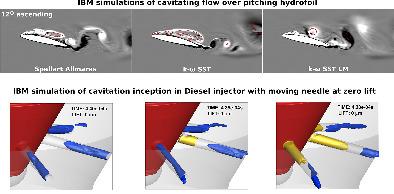当前位置:
X-MOL 学术
›
Int. J. Numer. Methods Fluids
›
论文详情
Our official English website, www.x-mol.net, welcomes your
feedback! (Note: you will need to create a separate account there.)
A direct forcing immersed boundary method for cavitating flows
International Journal for Numerical Methods in Fluids ( IF 1.7 ) Pub Date : 2021-07-05 , DOI: 10.1002/fld.5026 Evangelos Stavropoulos Vasilakis 1 , Carlos Rodriguez 1 , Nikolaos Kyriazis 1 , Ilias Malgarinos 1 , Pheovos Koukouvinis 1 , Manolis Gavaises 1
International Journal for Numerical Methods in Fluids ( IF 1.7 ) Pub Date : 2021-07-05 , DOI: 10.1002/fld.5026 Evangelos Stavropoulos Vasilakis 1 , Carlos Rodriguez 1 , Nikolaos Kyriazis 1 , Ilias Malgarinos 1 , Pheovos Koukouvinis 1 , Manolis Gavaises 1
Affiliation

|
In the current study, an immersed boundary method for simulating cavitating flows with complex or moving boundaries is presented, which follows the discrete direct forcing approach. Although the immersed boundary methods are widely used in various applications of single phase, multiphase, and particulate flows, either incompressible or compressible, and numerous alternative formulations exist, to the best of the authors' knowledge, a handful of computational works employ such methodologies on cavitating flows. The herein proposed method, following previous works of the author's group, tries to fill this gap and to solidify the development of a computational tool of a simple formulation capable to tackle complex numerical problems of cavitation modeling. The method aims to be used in a wide range of applications of industrial interest and treat flows of engineering scales. Therefore, a validation of the method is performed by numerous benchmark test-cases, of progressively increasing complexity, from incompressible low Reynolds number to compressible and highly turbulent cavitating flows.
中文翻译:

空化流动的直接强迫浸入边界法
在当前的研究中,提出了一种用于模拟具有复杂或移动边界的空化流的浸入边界方法,该方法遵循离散直接强迫方法。尽管浸入边界方法广泛用于单相、多相和颗粒流的各种应用,无论是不可压缩的还是可压缩的,并且存在许多替代公式,据作者所知,少数计算工作采用了此类方法论空化流动。本文提出的方法,遵循作者小组以前的工作,试图填补这一空白,并巩固能够解决空化建模的复杂数值问题的简单公式的计算工具的开发。该方法旨在用于广泛的工业应用和工程规模的处理流程。因此,该方法的验证由许多基准测试用例执行,这些用例的复杂性逐渐增加,从不可压缩的低雷诺数到可压缩和高度湍流的空化流。
更新日期:2021-09-06
中文翻译:

空化流动的直接强迫浸入边界法
在当前的研究中,提出了一种用于模拟具有复杂或移动边界的空化流的浸入边界方法,该方法遵循离散直接强迫方法。尽管浸入边界方法广泛用于单相、多相和颗粒流的各种应用,无论是不可压缩的还是可压缩的,并且存在许多替代公式,据作者所知,少数计算工作采用了此类方法论空化流动。本文提出的方法,遵循作者小组以前的工作,试图填补这一空白,并巩固能够解决空化建模的复杂数值问题的简单公式的计算工具的开发。该方法旨在用于广泛的工业应用和工程规模的处理流程。因此,该方法的验证由许多基准测试用例执行,这些用例的复杂性逐渐增加,从不可压缩的低雷诺数到可压缩和高度湍流的空化流。











































 京公网安备 11010802027423号
京公网安备 11010802027423号